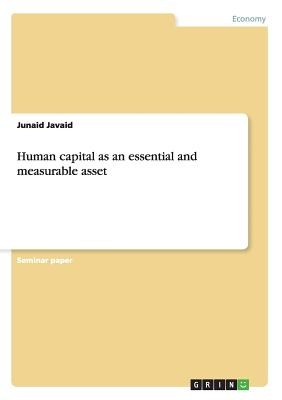
- We will send in 10–14 business days.
- Author: Junaid Javaid
- Publisher: GRIN Verlag
- ISBN-10: 3656838372
- ISBN-13: 9783656838371
- Format: 14.8 x 21 x 0.3 cm, softcover
- Language: English
- SAVE -10% with code: EXTRA
Reviews
Description
Seminar paper from the year 2012 in the subject Business economics - Business Management, Corporate Governance, grade: C+, University of Bedfordshire, course: MSc Finance & Business Management, language: English, abstract: This AMP is carried out as a research toward finding and relating the company's Human Capital with its desired performance. It has also suggested the method by which the company can reliably reports its Human Capital as the strongest company's asset in its financial statements. From the Background context of given issue the evidence looks prominent and right that in the current scenario Human Capital is considered to be as the key success factor. The Literature Review section, in relation to the definition of Human Capital, the arguments of both Becker (1993) and Davenport (1999) makes sense and also looks generous. Becker (1993) defined Human Capital as a composition of four characteristics (Credentials, Reputation, Personality and Appearance). While on the other side, Davenport (1999) made a figure of by combining all aspects (Employee effort, behaviour, ability & time) together to give final shape to undergoing definition. In relations to the measurement methods of Human Capital, there are many Scholars who came forwards and proposed different methods. It has been regarded and acknowledged that work of certain Authors: Kaplan & Norton (1992), Monti-Belkaou & Riahi-Belkaoui (1995), Brown (1999) and Weiss (1999) is prominent. Out of these four studies Monti-Belkaou & Riahi-Belkaoui (1995) took the fame as their model have both aspect: practical implementation and recognition of value added by the company's demployed Human Capital in its overall financial performance and operational excellence. The objectives of this AMP have been achieved. From the models like Balanced Scorecard and Kaplan's Seven Step Framework and also from the case studies like Huselid, et al (1997) and Delery & Doty, (1996), it has been cleared and u
EXTRA 10 % discount with code: EXTRA
The promotion ends in 18d.02:37:19
The discount code is valid when purchasing from 10 €. Discounts do not stack.
- Author: Junaid Javaid
- Publisher: GRIN Verlag
- ISBN-10: 3656838372
- ISBN-13: 9783656838371
- Format: 14.8 x 21 x 0.3 cm, softcover
- Language: English English
Seminar paper from the year 2012 in the subject Business economics - Business Management, Corporate Governance, grade: C+, University of Bedfordshire, course: MSc Finance & Business Management, language: English, abstract: This AMP is carried out as a research toward finding and relating the company's Human Capital with its desired performance. It has also suggested the method by which the company can reliably reports its Human Capital as the strongest company's asset in its financial statements. From the Background context of given issue the evidence looks prominent and right that in the current scenario Human Capital is considered to be as the key success factor. The Literature Review section, in relation to the definition of Human Capital, the arguments of both Becker (1993) and Davenport (1999) makes sense and also looks generous. Becker (1993) defined Human Capital as a composition of four characteristics (Credentials, Reputation, Personality and Appearance). While on the other side, Davenport (1999) made a figure of by combining all aspects (Employee effort, behaviour, ability & time) together to give final shape to undergoing definition. In relations to the measurement methods of Human Capital, there are many Scholars who came forwards and proposed different methods. It has been regarded and acknowledged that work of certain Authors: Kaplan & Norton (1992), Monti-Belkaou & Riahi-Belkaoui (1995), Brown (1999) and Weiss (1999) is prominent. Out of these four studies Monti-Belkaou & Riahi-Belkaoui (1995) took the fame as their model have both aspect: practical implementation and recognition of value added by the company's demployed Human Capital in its overall financial performance and operational excellence. The objectives of this AMP have been achieved. From the models like Balanced Scorecard and Kaplan's Seven Step Framework and also from the case studies like Huselid, et al (1997) and Delery & Doty, (1996), it has been cleared and u


Reviews